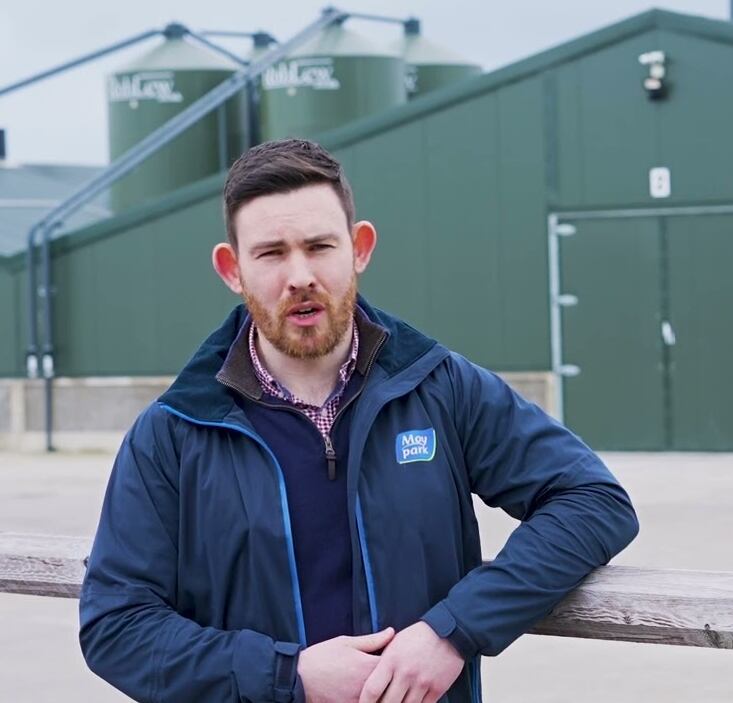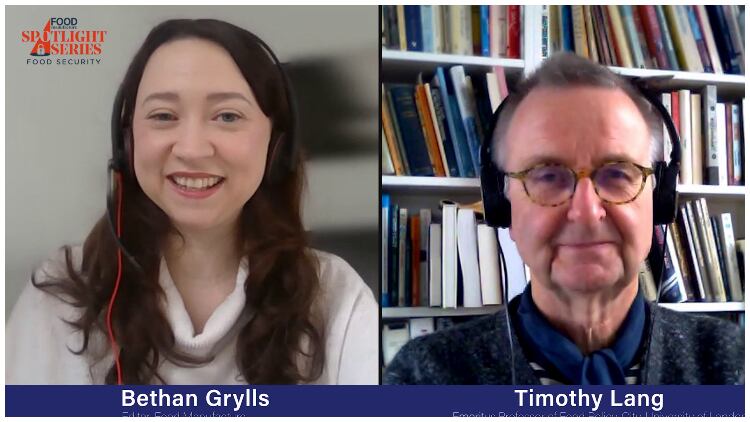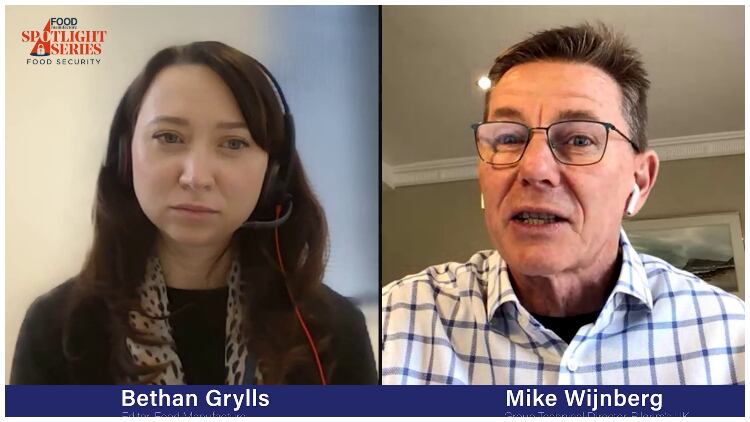Earlier this week, we heard from five experts from various points of the supply chain and categories to find out their thoughts on strengthening Britain’s food systems. Here’s what they had to say and if you’re keen to watch the webinar on-demand, you can do so here (for up to three months post live date).
Dr Aaron McKenna, head of customer support – agriculture at Moy Park
A localised, sustainable food system
For Aaron McKenna, head of customer support – agriculture at Moy Park, moving to more localised systems is a good starting point when it comes to enhancing supply chain robustness – but, as he adds, in a way that takes care of our environment.
When it comes to unsustainable systems drivers, McKenna doesn’t believe the blame or onus lies upon one area of production, but rather we should consider the food system as a whole.
“How have we ended up in a situation that has created the food system we have today? A lot of that is down to market and policy. We have set up a market that has generated the systems we have in place – and if we’re looking to move away from unsustainable practices, we need to examine the key drivers around what incentives are being put in place for primary producers. We need to look backwards to look forwards,” he contended.
“Traditionally our markets have been focused on delivering food at a relatively low cost for the consumer food rather than sustainable food,” he continued.
Although McKenna acknowledges that the right kinds of market environments are emerging, it will take a while for it to trickle through the entire supply chain from farm to supermarket shelf. “It will come in time; we need to get a policy in place to support it.”

“There’s loads to be done at a sectoral level too,” McKenna added. “Speaking from a poultry point of view, we have a streamlined supply chain that allows us to make significant changes within these chains relatively quickly.”
Figures suggest the UK is around 60% self-sufficient, which sounds decent, but as McKenna told Food Manufacture: “many would say we need to improve that figure to improve robustness”.
He continued: “The more food you grow closer to home, the more robust your supply chain is likely to be.
“Whilst the UK will be impacted by climate change, we’re probably less impacted than other places and that poses a good argument to start growing more on British soil. Energy security is probably where we are struggling the most, which is fundamental to food security.
“We have to be realistic though. We’re never going to be 100% self-sufficient, there will always be a place for imports. But ultimately, if we can grow more at home, we should do that.”
However, as McKenna highlights, our current government’s focus appears to be centred more on rewilding than food production – is this the right move as we head towards a future with a focus on home-grown products?
Right now, Moy Park itself is concentrating on data to measure aspects such as carbon footprint, and this is helping to flag where the company should be making its investments. A lot of that investment is going towards infrastructure – be it refrigeration or fleets (gas powered trucks, electrification of company cars, etc.) or facilities, such as its recent state-of-the-art poultry farm which will be acting as a blueprint for future Net Zero broiler farming.
Rupert Ashby, chief executive at the British Frozen Food Federation
Can Britain be completely self-sufficient?
Looking at how the semantics around food security can be perceived, Rupert Ashby, chief executive at the British Food Federation (BFFF), explained that for some it’s about having the capability to produce food within your own shores.
“But the reality is, with our diverse diets, we can’t produce everything in the UK,” he acknowledged. “Realistically, food security means a number of things, increased access to nutritious food, food from a number of sources that caters for all our tastes and a supply chain that allows for breakdowns, with events such as climate or, as we have sadly seen recently, conflict.
“We need a productive agricultural sector investing in technology and efficiency, and an efficient and innovative storage system, but also national relations with other countries.
“We live in a global economy, it’s important to value our trading relationships. Self-sufficiency isn’t the same as food security. We are part of a global food system, and that provides us with all the diversity and supply we need, particularly those things that cannot be produced domestically.
“But there will be those that argue the world is becoming less ordered than it has been, the war between Russia and Ukraine has showed us in a very stark way how quickly a food chain can collapse. This is further exacerbated by international trading rules and climate change.
“We need to be thinking about shorter supply chains and more resilient chains, so they do not break under pressure.”
Adding to this, Ashby emphasised that although government intervention is necessary, the decisions it takes must be informed by industry.
“We want good policies wherein the industry has fed into them and not ones that have been formed around a department table and that may have unintended consequences,” he stressed.
Could frozen food be the answer to food insecurity?
Exploring solutions emerging with frozen foods, where the BFFF focuses its work, Ashby was optimistic about this category’s role in food security.
“There are so many benefits, even as a back-up – if you can’t get hold of veg in the supermarket, if you have frozen in the deep freeze then you’re covered.”
Moreover, although frozen foods often have a bad reputation when it comes to health, they’re actually a lot better at retaining nutrients and vitamins than fresh.
“We call it nature’s pause button,” Ashby said.

But however good it is at locking in nutrients, is frozen a sustainable storage solution?
“Yes, we can still be energy efficient with frozen,” stated Ashby. “For example, if you buy frozen food, you’re not going to be constantly popping back and forth to the supermarket. The process of handling, transportation and logistics are much less complicated for frozen too.”
Ashby also pointed out the carbon emissions that can be attributed to food waste: “We all do it, forget something at the back of the fridge. Also, with frozen food you have portion control…you only use what you need. If we could even halve that carbon emitted [from food waste in the home] that would probably dwarf what we’d be using to freeze it.”
Whilst Ashby argues ways frozen could counteract its energy use, we’re also seeing some interesting research come from companies such as Unilever as it experiments with freezer temperatures.
The food giant is currently trialling warmer ice cream freezer cabinets with an aim of reducing energy use and greenhouse gas emissions by around 20-30% per freezer, whilst ensuring the same ice cream quality and consumer experience.
With a current industry standard in many markets of -18°C, Unilever’s ambition is to move the temperature of its retail sales freezers to -12°C to improve energy efficiency and reduce greenhouse gas emissions, in a move which it hopes will drive industry-wide change.
Hellmann’s (a brand under the Unilever group) is also testing out a special edition ‘smart jar’ that can inform the individual when their fridge is at the right temperature. By using temperature-sensitive ink, the design changes when the fridge is set below 5℃, signified by a hidden layer being revealed.
Certain foods can last up to three days longer in a fridge set below 5℃ (vs. 7℃), including milk – one of the most wasted food products in your fridge, according to Hellmann's.
Trial prototypes with a unique label design from illustrator Ellen Porteus were sent to Hellmann’s fans, food waste campaigners and influencers nationwide to raise awareness of food waste during Food Waste Action Week, which took place earlier this month.
Commenting on these kinds of approaches from the frozen perspective, Ashby said: “The industry has a duty to look at how it can be sustainable and efficient. Increasing freezer temperatures is one area that could be a potential answer. But could we also, for example, freeze the food rather than the room around it, could we turn off the fans for a period of time so it does not affect the food?
For this kind of research to become more of a commercial reality however, “there will need to be collaboration not just in the UK but worldwide and there will need to be changes in legalisation and how it impacts different foods”.
Robert Griffiths, technical specialist in lipids & Carole Bingley, technical specialist in product development at Reading Scientific Services Ltd
Understanding the food safety risks posed by fragile supply chains
Speaking on the drivers for supply chain disruption, Robert Griffiths, technical specialist in lipids at RSSL, raised a number of issues but said one of the biggest impacts has been the Russian invasion.
“It’s driven prices for sunflower oil up very high,” he commented, “but it’s also hiked up prices of other oils and fats and also the availability for some of the derivatives, such as sunflower lecithin, an important emulsifier used in lots of different foods products.”
“Manufacturers have responded in a few ways – one is to try and secure additional supply from current suppliers or to work with new suppliers.
“Some of the biggest manufacturers have a network of suppliers and can use their scale to ensure they get priority of supply.” In some cases, where it has been possible, disruption has also led manufacturers ordering larger volumes.

But not everyone has the benefit of scale. Sometimes a manufacturer just has to make use of what is available on the market, whilst others will look at what they can make use of already in their stock and even ways of extending shelf-life.
As some manufacturers look to alternative ingredients as their original go-tos run into supply issues, there are several things to consider. This includes quality, stability, texture and taste, but the most concerning is undoubtedly fraud.
“When ingredients are in short supply, it’s a greater temptation for fraudsters,” cautioned Griffiths. “The fraudulent products aren’t easy to spot. Using reputable suppliers is a good start but you should always get a certificate of analysis (COA) with the ingredient. If you’re using a new supplier and even with your current supplier, you might want to carry out testing to just double check.
“A COA doesn’t guarantee that a product isn’t adulterated or contaminated, it often involves quite a lot more of in-depth analysis to determine if something is genuine. These tests aren’t always on a COA!”
Adding further advice, Carole Bingley said: “Take a look at the ingredients you use in your products; understand which are vulnerable, have conversations with your suppliers what is on the horizon.”
Bingley also suggested having a second supplier on hand for a certain ingredient and appreciating that in some cases reformulation and removing an ingredient isn’t the answer.
“Wheat flour is a great example, we know how difficult it is to formulate gluten-free product - it ends up being very different. So are there ways you can just reduce the amount of those ingredients and manage supply issues in that way?”
Sally-Ann Krzyzaniak, Tate & Lyle, director, regulatory and scientific affairs
Could fortification help strengthen food security?
Looking at food security from a health and nutrition perspective, Tate & Lyle’s director, regulatory and scientific affairs expressed a concern that some people are having to make choices between health and pennies.
“In those circumstances nutrition can be impacted,” said Sally-Ann Krzyzaniak, as she gave a nod to those in the industry working towards reducing levels of fats, sugars and salt.
“It’s a case of trying to make sure those everyday drinks and food that we rely on are tasty and healthy.”

Elaborating further, Krzyzaniak revealed that the vast majority of Brits are not getting their recommended intake of fibre and are not aware of the 'fibre gap' in their diets.
To help address this, the ingredients organisation has partnered with the British Nutrition Foundation to build consumer awareness of the need for fibre by creating a fibre calculator. If your answer shows your fibre intake to be low, users will then be given tips on how they can increase it.
Why is this important? According to Tate & Lyle's modelling, increasing the fibre content of everyday UK foods would enable 50% more adults to get the recommended daily amount of fibre in their diets. It would also lower the risk of heart disease and diabetes for the majority of UK adults. “By choosing the right ingredients, the foods that food and drink brands fortify still taste great and perform the way you’d expect them to,” she added.
Temperatures, toxins and transport, oh my!
However, as was mentioned by her peers, Krzyzaniak recognises the challenges that climate change is posing on supply chains.
“Climate change is affecting all of us, all the time. Last summer, we saw areas where there was drought – and that can impact transportation of materials. Low water level in The Rhine made it difficult to transport barges of corn.
“We’ve seen other areas where the summers are getting hotter and wetter and with that there is a risk of more moulds and contaminants like aflatoxins.”
To address this, Krzyzaniak said Tate & Lyle has rigorous quality control systems in place to make sure the corn it uses adheres to quality standards and is safe. It is also working with trade associations such as Starch Europe to collate data on aspects such as aflatoxins, which then feeds into the EU Commission so it can understand the impact of weather on raw materials and assess what needs to be monitored.
The future is uncertain
The drivers and impacts of food insecurity are substantial, as our speakers throughout this Spotlight Series week have highlighted. As Food Manufacture reported last month, the UK has trapped itself in a vicious cycle of rising costs, environment degradation and increasing public health costs.
It is clear that our food system is not working as well as it should be – and although the last few years of shocks has revealed our flexibility in times of friction and uncertainty, it has also shaken our foundations so fiercely that the cracks can no longer be ignored. We can't expect to keep pivoting at the last moment, we need to be prepared - as much as we are able.
As Tim Lang of City University suggested in the concluding episode of Food Manufacture's documentary examining food insecurity in the UK, as an industry we've been giving things a good go, but now it's not been enough. Now is the time to address these challenges with everything we've got, whilst intensifying the pressure on government to support and facilitate.
This Spotlight Series was sponsored by RSSL.





